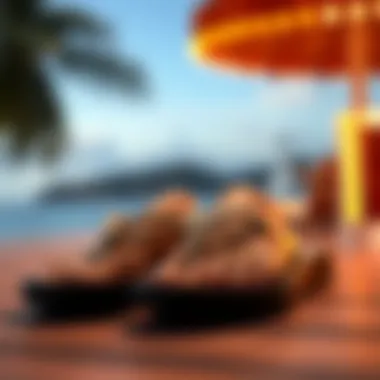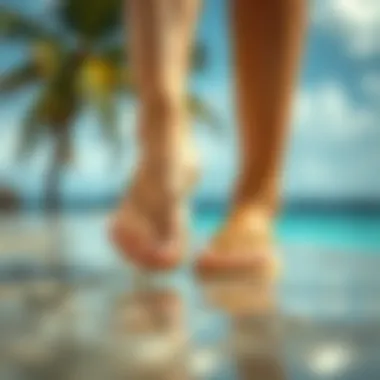The Evolution and Impact of Toe Post Flip Flops


Intro
Toe post flip flops, often seen as casual summer staples, have a rich history that intertwines with various cultures around the globe. From humble beginnings in ancient civilizations to their current status as a noteworthy fashion statement, these sandals encapsulate more than just simplicity. With their distinct design, they showcase a blend of functionality and aesthetics, ultimately influencing foot health and style preferences. In this piece, we will wander through their evolution, examining the materials used and iconic styles that have emerged through the ages.
Clothing Trends Analysis
Current Trends in Seasonal Fashion
Today, toe post flip flops are more than just beachwear. They have found their way into runways and everyday street fashion, embraced by designers who cleverly merge comfort with chic designs. Trending this season are brands offering environmentally friendly materials and innovative designs, such as those featuring sustainable leather and recycled plastics. The color palette ranges from bright hues reminiscent of sun-soaked shores to muted earth tones that evoke a sense of minimalism.
For many fashion-forward individuals, toe post flip flops are now a fundamental part of the seasonal wardrobe, crossing the lines between casual and sophisticated.
Iconic Styles Through Decades
The history of toe post flip flops tells a fascinating tale of transformation.
- 1940s-1960s: During this period, simple rubber flip flops became popular post-war as they were affordable and functional. They were often associated with leisure and laid-back lifestyles.
- 1970s: The introduction of various textures and patterns made flip flops a fashion item rather than just a utility footwear. Brands like Havaianas began to emerge, bringing vibrant colors to the forefront.
- 1980s-1990s: In this era, toe post flip flops saw a shift with the rise of designer versions introduced by luxury brands, elevating their status.
- 2000s-Present: Now, toe post flip flops blend seamlessly with high fashion, boasting collaborations between acclaimed designers and brands, resulting in limited editions that draw attention.
Understanding these trends helps designers and stylists grasp how the footwear has been molded by societal changes and consumer expectations over time.
Styling Tips and Techniques
Essential Tips for Wardrobe Versatility
Incorporating toe post flip flops into various outfits can be very rewarding if done right. Here are a few tips:
- Mix and Match: Pair flip flops with tailored shorts or a flowy maxi dress to create a chic yet comfortable look.
- Accessorize Wisely: Use statement jewelry to elevate casual outfits comprising flip flops; this brings a touch of finesse.
- Choose Quality: Invest in well-made flip flops that not only look good but also provide support to maintain foot health.
Layering Techniques for Effortless Looks
When styling toe post flip flops, layering can immensely enhance your overall look. Consider these techniques:
- Layer with light outerwear: A denim jacket or a lightweight kimono can add a trendy vibe while still allowing breathability.
- Mix textures: Combine smooth fabrics with rougher textures, such as a crochet top with sleek shorts and flip flops for a multipurpose outfit.
- Embrace versatility: Wear ankle socks with flip flops for an unexpected twist—this trend has made a comeback, particularly among the younger crowd.
By blending traditional designs with contemporary flair, toe post flip flops continue to evolve, reflecting wider trends in the fashion world.
For more insights about sustainable materials in footwear, check Wikipedia.
To explore more about historic fashion impacts, visit Britannica. Learn about unique fashion expressions on Reddit.
As the conversation around comfort meets style evolves, it is crucial to keep an eye on how these beloved sandals shape consumer behaviors and attitudes toward footwear in the modern age.
Prelims to Toe Post Flip Flops
Toe post flip flops are not just a style of footwear; they embody a blend of comfort, functionality, and cultural significance. Their importance straddles the line between casual wear and contemporary fashion, making them a relevant topic for designers, stylists, and fashion students alike. This article aims to shed light on the evolution of these flip flops, illuminating their path from humble beginnings to their current status within the fashion industry.
Exploring toe post flip flops leads to gaining insight into how fashion evolves and merges with utility. The consideration goes beyond aesthetics; it's about understanding how these sandals have various meanings attached to them across different cultures. From beach outings to urban jungles, flip flops have found their place in our daily lives.
One benefit that stands out is their versatility. Ease of wearing and the minimalistic design offer a relaxed vibe that appeals to a broad audience. However, there's also the conversation about appropriateness in certain settings, and how some styles are perceived differently based on cultural perspectives. Moreover, it's essential to discuss the functional aspects—like comfort and foot health—that are often overlooked in fashion discussions.
Through this article, readers should appreciate not only the aesthetics of toe post flip flops but also their deep-rooted significance. They span numerous cultures, embodying various fashion statements across generations.
Definition and Characteristics
Toe post flip flops are defined by their simple structure, consisting of a flat sole with a Y-shaped strap that secures the foot between the first and second toes. Typically made from rubber, foam, or other lightweight materials, their design emphasizes breathability and ease of wear. They are popular for their practicality and casual flair. Characteristically, these foot coverings are easy to slip on and off, making them an ideal choice for warm weather and beach trips.
Several defining traits make toe post flip flops stand out:
- Material Variety: From basic foam to eco-friendly options, the materials used can vary widely, contributing to comfort levels and durability.
- Design Flexibility: Colors, patterns, and decorative elements can transform flips flops from a simple utility item to a fashion statement.
- Adaptability: They can be found in settings ranging from casual outings to more upscale events, depending on their configuration.
Cultural Origins
Historically, the evolution of toe post flip flops can be traced to various cultures around the globe. Many ancient civilizations created footwear resembling modern flip flops, emphasizing their long-standing utility. For example, the Japanese zori sandals and the ancient Egyptian sandals both feature similar minimalist designs that are incredibly functional.
In the early 20th century, the influence of different cultures expanded the design and usage of flip flops. With globalization in full swing, the aesthetics and designs borrowed from different parts of the world began to take root. This is particularly seen in the American interpretation during the post-war era, when the flip flop surged in popularity, symbolizing a laid-back lifestyle associated with beach culture and freedom.
The spread and adaptation of this footwear highlight how fashion transcends individual cultures, leading to a hybridization of style that reflects the changing landscape of society. With each variation, toe post flip flops carry traces of the cultures that crafted them, embracing diversity while still serving a universal need for comfort and ease.


The Historical Context
Understanding the historical context of toe post flip flops provides significant insight into how they became a staple in modern footwear. This examination sheds light on not only the evolution of design but also the cultural exchanges that have influenced their style and function. The manner in which these sandals have traversed various societies speaks to a narrative of adaptation and resilience. From early use in practical settings to their eventual embrace in fashion-forward circles, the journey of toe post flip flops is rich with fascinating details that highlight their versatility and enduring appeal.
Early Variants of Flip Flops
The earliest forms of flip flops can be traced back thousands of years. Ancient Egyptian sandals, made from papyrus or palm leaves, resemble the toe post style notably found in modern flip flops. In this era, luxury was not just in the material but also in the craftsmanship. These sandals were often adorned with intricate designs, showcasing the wearer's status. Additionally, the Japanese wore "geta" and "zori" - wooden and straw sandals that provided a similar separation between the toes and sole.
"Sandals of yore blend practicality with a touch of elegance, serving as both foot protection and style statement."
These early iterations not only protected feet but also reflected the social hierarchies of their time. Found in tombs and depicted in artworks, these sandals were more than mere footwear. They represented an intersection of comfort, wealth, and artistry, setting the stage for the cultural significance of today's flip flops.
Evolution Through Age and Culture
As we move through history, different cultures adapted the sandal design according to their environmental needs and aesthetic preferences. In India, for instance, the "chappal" holds a deep significance. Traditionally crafted from leather, these sandals reflected not just regional craftsmanship but a way of life deeply woven into the cultural fabric.
Meanwhile, the 20th century saw a transformation in the perception of flip flops in the West. Initially dismissed in mainstream fashion, they were adopted by the counterculture of the 1960s and 70s, becoming symbols of rebellion and freedom. The casual nature of the flip flop resonated with the laid-back lifestyle ideals of that time.
As surf culture surged in popularity, brands like Havaianas and Reef capitalized on the flip flop’s casual appeal, introducing vibrant colors and innovative materials that would shape modern designs. Today, these sandals vary widely, incorporating everything from eco-friendly materials to ergonomic designs, appealing to a broad audience that values both comfort and style. Their evolution from utilitarian objects to fashion statements is substantial, showing how adaptability is central to their history.
Materials and Construction
The Materials and Construction of toe post flip flops are foundational aspects that shape not only their comfort and style but also their sustainability and foot health. As these sandals have evolved over time, so too have the materials used in their creation. Understanding these elements provides insight into why certain flip flop styles resonate with consumers and the implications for their longevity and environmental impact.
Traditional Materials
Historically, toe post flip flops were crafted from natural materials readily available in their cultural environments. Leather, jute, and rubber are just a few examples of these traditional materials. Each one brings distinct benefits:
- Leather: Known for its durability and aesthetic appeal, leather molds to the shape of the foot over time, creating a personalized fit. It's often associated with higher-end flip flop designs, giving a sophisticated edge to casual footwear.
- Jute: A sustainable fiber, jute is often used in the sole of flip flops. Its natural texture provides a unique look and feel, and its biodegradability makes it a great choice for environmentally conscious consumers.
- Rubber: This material is a staple in the flip flop world, offering water resistance and flexibility. Rubber soles are particularly common in beachwear, as they provide good traction on wet surfaces.
Switching to modern production practices, while these traditional materials have not completely faded, they have been enhanced with newer technologies, resulting in a blend of practicality and style in toe post flip flops.
Modern Advances in Footwear Design
The landscape of toe post flip flops has seen remarkable shifts due to advancements in footwear design and material science. Designers today are not just focused on aesthetic appeal but also on integrating comfort and functionality into their products. Some modern innovations include:
- EVA Foam: Ethylene Vinyl Acetate (EVA) foam has become widely used in the construction of flip flops due to its lightweight, cushioned properties. It absorbs shock effectively, making it a popular choice for individuals seeking comfort without sacrificing style.
- Orthotic Footbeds: Many brands now incorporate orthotic design principles into their flip flops. These footbeds provide arch support and better alignment, critical for those who are on their feet for extended periods.
- Recycled and Eco-Friendly Materials: As sustainability continues to gain traction, more brands are using recycled plastics and sustainable rubber in their designs. This innovation not only reduces waste but also caters to a growing consumer base that prioritizes environmentally responsible products.
"The combination of traditional craftsmanship and modern technology in toe post flip flops reflects an era where style and sustainability walk hand in hand."
To summarize, the journey of materials and construction in toe post flip flops highlights a vibrant collaboration between the past and present. Traditional materials provide a rich history, while modern advances cater to evolving consumer preferences, particularly concerning comfort and sustainability.
To learn more about the materials in footwear, you can visit Wikipedia. For insights into footwear technology, Britannica provides a comprehensive overview.
Styles of Toe Post Flip Flops
Toe post flip flops aren’t merely casual footwear; they’ve evolved into a versatile fashion statement. The significance of styles within this category can’t be overstated. The choices in design speak volumes about individual preferences and the nuanced interplay of culture, comfort, and trend. Here, we’ll delve into two primary styles: casual and formal options, alongside the cutting-edge trendy designs that run rampant in today’s fashion landscape.
Casual Versus Formal Options
Casual toe post flip flops are the bread and butter for many; they’re typically constructed from simple materials like rubber or foam and are designed for everyday wear. This type of flip flop is favored for its comfort and practicality. However, as the demand for stylish footwear grows, the line between casual and formal has started to blur.
Casual flip flops can often feature vibrant patterns, bold colors, and playful embellishments. These are perfect for beach outings or backyard barbecues. For example, brands like Old Navy frequently release designs catered to a youthful audience, ideal for pairing with casual summer dresses or board shorts.
On the other hand, formal toe post flip flops come with a certain finesse and an eye for sophistication. These styles often use materials like premium leather or synthetic equivalents that mimic the look of leather. Brands such as Havaianas and Reef have designed chic alternatives that can complement lighter suits or elegant sundresses, making them suitable for more polished settings such as summer weddings or garden parties.
The key element in choosing between casual and formal lies in the occasion. Comfort needs to be balanced with aesthetics.
Trendy Designs and Customizations
As the fashion world continually evolves, toe post flip flops now feature a variety of trendy designs that cater to an array of tastes and preferences. From embellished straps to eco-friendly materials, there’s an option for every individual. Some flipping designs even incorporate intricate beadwork or floral accents, pushing the envelope of creativity.
Customization has also become increasingly popular. Some brands even allow consumers to design their very own flip-flops, with choices regarding color, material, and embellishments. Websites like FlipFlopShop offer such services, letting customers stand out from the crowd with unique styles tailored just for them.
Moreover, there's an emerging trend in sustainable flip flops, where brands utilize recycled materials or bio-based products to create stylish footwear. This trend doesn’t just look good; it feels good too, aligning with a growing consumer focus on environmental consciousness. For instance, Teva integrates recycled plastic into their designs, making a notable impact while remaining fashionable.
Comfort and Foot Health


In the realm of footwear, toe post flip flops often elicit mixed feelings, with comfort being a significant talking point. These sandals are more than just a summer staple; they straddle the line between practicality and style. Understanding this juxtaposition of comfort and foot health is crucial, especially for those who spend extensive periods on their feet or are often on the go.
The Anatomy of Footwear and Support
Toe post flip flops come with a simple structure but encompass a number of components that contribute to their comfort and support. At the core of their construction is the outsole, typically made of rubber or foam, which provides grip and shock absorption. This is where the flexibility of the footwear shines.
- Toe post design: This feature holds the flip flop securely on the foot while allowing for adequate ventilation. However, if the design is too rigid or the toe post is positioned poorly, it can cause discomfort.
- Arch support: Some brands, such as OluKai and Teva, offer enhanced arch support, recognizing that a flat sole can lead to foot fatigue over time. This support can help distribute the body weight evenly across the foot, reducing undue stress on specific areas.
- Cushioning: Many modern flip flops incorporate additional cushioning materials. Ethylene-vinyl acetate (EVA) foam, for example, not only increases comfort but also durability, making it a popular choice among footwear designers.
Understanding these components can be the difference between a pleasurable experience and pain at the end of a long day. The right pair can offer that sweet spot where fashion meets function, enabling wearers to enjoy their daily activities without unnecessary strain on their feet.
Potential Health Concerns
Despite their advantages, toe post flip flops can inadvertently contribute to various health issues if not selected wisely. It's important to be aware of the potential downsides to make informed decisions when purchasing these sandals.
- Flat soles and lack of support: Many traditional flip flops lack arch support and cushioning, which can lead to problems like plantar fasciitis or tendonitis, particularly for those with pre-existing foot conditions.
- Inadequate traction: The smooth outsole of some flip flops decreases grip, increasing the risk for slips and falls, particularly on wet surfaces. When choosing flip flops for outdoor activities, it’s best to consider models with textured soles.
- Toe post irritation: Prolonged wear of flip flops with stiff or poorly designed toe posts can lead to irritation or blistering between the toes, which can be not only uncomfortable but also predispose wearers to infection.
"Choosing the right flip flop is not only about style; it's pivotal to prioritize comfort to avoid foot ailments down the road."
The essential takeaway is that while toe post flip flops can be stylish and convenient, they often require thoughtful selection and awareness of their fit and function. When chosen wisely, they can offer a level of comfort and support that promotes overall foot health.
Sustainability in Production
Sustainability in production has become a critical subject across various industries, including footwear. As the world increasingly grapples with environmental concerns, it is vital to examine how toe post flip flops can be produced in an eco-conscious manner. This section highlights the necessity of sustainable practices within the flip flop market, emphasizing the significance of eco-friendly materials and responsible manufacturing practices.
Sustainability means balancing economic growth with the well-being of our planet. For designers and manufacturers alike, adopting sustainable practices not only meets consumer demand for green products but also contributes to a healthier environment. Designers should be equipped with insights on how to integrate sustainable principles into their work while maintaining style and comfort in their designs.
Eco-Friendly Materials
When it comes to toe post flip flops, the choice of materials plays a pivotal role in determining the environmental impact of production. To be truly sustainable, manufacturers must explore alternatives to conventional materials that often contribute to pollution and waste. Here are some eco-friendly materials making their way into modern flip flop designs:
- Recycled Rubber: An excellent choice for soles, recycled rubber repurposes used materials, reducing landfill waste and minimizing the demand for new resources.
- Biodegradable Plastics: These materials break down more easily in the environment, lessening the long-term impact on wildlife and ecosystems.
- Natural Textiles: Organic cotton and hemp provide breathable and comfortable options for straps, while being less harmful to the environment than traditional cotton, which is often laden with pesticides.
- Bamboo: The rapid growth of bamboo makes it highly renewable, making products crafted from this material an eco-friendly choice. It also has natural antibacterial qualities.
By prioritizing materials like these, designers can contribute to a more sustainable industry while also tapping into a growing market segment that places a premium on eco-friendliness. Consumers are increasingly discerning, seeking out products that reflect their values, and brands that adopt these materials often stand out in a crowded marketplace.
Responsible Manufacturing Practices
Beyond the materials used, the methods employed in the manufacturing process are equally important in achieving sustainability. Responsible manufacturing practices ensure that production not only limits environmental harm but also supports fair labor practices and community well-being. Here are some fundamental practices to consider:
- Energy Efficiency: Adopting energy-efficient technologies and processes reduces carbon footprints. Using renewable energy sources can further enhance the sustainability of manufacturing facilities.
- Waste Reduction: Manufacturers should strive to minimize waste through improved resource management, recycling scrap materials, and optimizing production processes to create less surplus.
- Sustainable Supply Chains: Collaborating with suppliers who share values on sustainability can enhance the overall impact of the production process. Ensuring ethical labor practices and reducing transportation emissions also contribute positively to sustainability efforts.
- Local Sourcing: By sourcing materials and labor locally, companies can reduce the carbon footprint associated with long-distance transportation. This practice also supports local economies and communities.
"Sustainable practices in production do not merely reflect a shift in methods; they reflect a shift in mindset, aligning industry standards with the pressing needs of our planet."
Incorporating these practices can help brands cultivate a loyal customer base that values ethical considerations. As consumers become more educated and aware of environmental issues, companies that demonstrate an ongoing commitment to sustainability may flourish in the competitive landscape of fashion.
As we see a growing trend towards sustainable practices in the footwear industry, toe post flip flops have the potential to lead the charge. By taking mindful steps in material selection and manufacturing methods, designers and brands can create a brighter future for both the planet and the flip flop industry.
Styling Tips for Toe Post Flip Flops
When it comes to toe post flip flops, the first thought might not be about fashion. However, these humble sandals easily blend into various styles, becoming a staple in many wardrobes. Knowing how to style toe post flip flops can elevate an outfit while offering comfort. This section aims to unravel the various considerations to keep in mind when pairing and accessorizing with these casual classics.
Pairing With Different Outfits
Toe post flip flops aren’t just for the beach. Understanding the versatility of these sandals is key to making the most of them.
- Casual Chic: Pairing toe post flip flops with denim shorts and a flowy blouse creates a laid-back yet stylish look. This combo is perfect for a brunch date or a day out in the sun. Opt for neutral-toned flip flops, like tan or white, to keep it grounded.
- Dress it Up: Yes, you can wear flip flops with sundresses too! For a relaxed summer event, consider a bright floral dress with a matching pair of toe post flip flops. The key here is to ensure the dress has a flattering cut, making the flip flops seem intentional rather than an afterthought.
- Office Appropriate: While toe post flip flops are often seen as casual wear, you can style them for work. A fitted pair of trousers combined with a blazer and elegant toe post flip flops can make for a trendy, more relaxed office ensemble. Look for slick materials or subtle patterns that keep the look professional.
"Comfort doesn’t have to sacrifice style. Toe post flip flops can indeed navigate through rough fashion territory with the right attire."
Accessorizing for Visual Balance
Accessorizing is vital when it comes to styling toe post flip flops. The right accessories can transform a simple outfit into something striking.
- Jewelry: Minimalistic jewelry works wonders. Think thin bangles or delicate necklaces that don’t distract from the simplicity of the flip flops. Wearing small hoop earrings can also draw attention upward, creating a balanced look.
- Bags: Choose bags that complement your flip flops. A straw tote is perfect for beach outings, while a leather crossbody bag adds sophistication for more urban settings. Ensure the colors don’t clash with the sandals to maintain harmony.
- Hats and Sunglasses: A wide-brimmed hat and oversized sunglasses can complete a summer outfit perfectly. These additions not only enhance the style but also provide practicality against the sun, making your look functional.
Incorporating these styling tips can enhance the aesthetic value of toe post flip flops, making them a go-to option for various occasions. As consumers increasingly seek comfort without sacrificing style, savvy fashion lovers will find ways to embrace these beloved sandals.
For more insights on fashion and styling, check out:


Consumer Preferences and Trends
In the fast-paced world of fashion, understanding consumer preferences and trends is pivotal. This section delves into how modern tastes and market dynamics shape the evolution of toe post flip flops.
Market Analysis and Popularity
Toe post flip flops have matured from being merely a casual footwear choice to a staple demand across diverse demographics. The market analysis reveals surprising shifts in consumer behavior. For instance, during the summer months, sales soar, and brands often compete on aesthetics and comfort. Manufacturers are now analyzing data to pinpoint which designs attract younger audiences. The youth tends to favor brightly colored options, uniquely printed straps, and customizable elements, while older generations lean towards classics like neutral tones and supportive features.
Trends indicate a significant increase in the popularity of brands like Havaianas and Birkenstock, not only for comfort but also for their fashion statements. Collaborations with influencers and designers have helped these brands forge a path into the mainstream, amplifying their visibility. A statistic from a recent report highlights that 65% of consumers have purchased footwear inspired by social media or influencer recommendations, showcasing the weight of social validation in the purchasing process.
"In today’s marketplace, it’s not just about comfort; it’s about making a fashion statement that resonates with personal identity."
Beyond mere aesthetic appeal, functionality increasingly shapes buying decisions. Many consumers seek out flip flops that offer arch support, durability, and materials that stand up to wear and tear. Eco-friendliness is also coming into play—with many opting for brands that use sustainable materials, thus demonstrating a growing preference towards ethical consumption. This attunes with the conscience of today’s buyer, who often seeks to align their purchases with their values.
Influence of Social Media on Choices
Social media has woven itself into the very fabric of consumer decision-making. Platforms like Instagram and TikTok serve as visual catalogues where styles can be explored and showcased. Influencers sometimes wield greater pull than traditional advertising, catalyzing trends overnight. A glance at trending hashtags can illuminate what consumers are clamoring for.
For example, when an influencer posts a stylish image sporting bright, patterned toe post flip flops, their followers are likely to jump on the bandwagon. This phenomenon reveals the power of peer influence driving consumer preferences, often leading to impulsive buying behaviors. An online survey indicated that about 70% of millennial buyers feel pressure to use the footwear choices that are 'in vogue'.
Moreover, social media platforms facilitate easier engagements with brands. Consumers now request feedback and clarifications through comments or direct messages, fostering a more interactive shopping experience. They might share their thoughts on comfort, look, and fit, contributing to the dialogue around what makes a pair of toe post flip flops desirable.
Both factors—the foundational shifts in general purchasing trends and the direct influence of social media—underscore the intricate relationship between consumer preferences and the evolution of toe post flip flops. Keeping an eye on these patterns can help designers, marketers, and retailers navigate the waters of fashion effectively, ensuring that their offerings resonate deeply with the audience.
This interplay between market dynamics and social forces shapes the future direction of the toe post flip flop phenomenon, presenting both challenges and opportunities across the footwear industry.
The Future of Toe Post Flip Flops
The evolution of toe post flip flops has taken us on quite a journey from their humble beginnings to modern-day fashion staples. Understanding where they are headed is as vital as tracing where they’ve been. This section sheds light on the anticipated advancements and hurdles that could shape the direction of toe post flip flops in coming years, creating a solid discussion around their place in both the fashion industry and consumer lifestyle.
Innovative Designs on the Horizon
Designers are constantly pushing the envelope, merging comfort with creativity. We are likely to witness a wave of innovative designs, driven not just by aesthetics but also by functionality. Imagine flip flops infused with smart technology, like adjustable arch support that molds to the wearer’s foot. Brands may delve deeper into biodesign, using materials grown from natural organisms that offer durability while being environmentally sustainable.
Some potential trends could include:
- Minimalistic Silhouettes: A move towards slimmer designs, allowing for a sleek look without compromising comfort.
- Cushioning Innovations: More brands might adopt advanced foam technologies, enhancing the cushioning effect and making wearability a joy.
- Adaptive Sizing: Imagine flip flops that adapt to the wearer’s foot size throughout the day, providing a tailored fit regardless of activity.
- Eco-Conscious Options: Moving beyond just materials, designs may embrace sustainable practices, like closed-loop systems where old footwear is returned for recycling.
"The future is about marrying comfort with conscious living; every step counts, literally and figuratively."
Challenges Facing the Industry
Despite the exciting prospects, the journey ahead isn’t without its bumps. The toe post flip flop market faces myriad challenges that could impede creative advancements. High manufacturing costs remain a major hurdle; sustainable materials and innovative processes often come with a hefty price tag that smaller brands may struggle to shoulder.
In addition, competition is fierce. Fast fashion's grip on the market means that many quality brands find it hard to stand out. The pressure to produce affordable yet fashionable footwear may also exacerbate environmental concerns, as quality frequently gets sacrificed for lower production costs.
Here are a few challenges the industry might confront:
- Sustainability vs. Affordability: Striking a balance between eco-friendly practices and keeping prices accessible for the average consumer.
- Consumer Awareness: As the trend for sustainability grows, so does the consumer demand for transparency in production practices. Brands that do not align with these values may fall out of favor.
- Market Saturation: With numerous options flooding the market, distinguishing a product's unique value proposition is pivotal amidst a sea of similar offerings.
To navigate these challenges, brands must pivot towards innovation, listen attentively to consumer feedback, and commit to sustainability without losing sight of style. The future of toe post flip flops, fraught with challenges, holds the promise of transformation and growth.
Culmination
The significance of toe post flip flops stretches beyond mere convenience and comfort; they embody a journey through history, culture, and modern fashion. This article has delved into the various dimensions of these ubiquitous sandals, exploring their development over time and the factors impacting their design and usage in contemporary settings.
Recap of Key Insights
Throughout this exploration, several key insights emerged:
- Cultural Roots: Toe post flip flops date back to ancient civilizations, where they began as practical footwear for everyday activities and quickly evolved to align with cultural norms across the globe.
- Materials and Sustainability: The transition from traditional materials to eco-friendly alternatives highlights how current trends in sustainability influence not just the fashion industry but also consumer behavior. Brands striving for responsible manufacturing practices reflect a growing consumer awareness around environmental issues.
- Health Considerations: There is a duality in the comfort offered by flip flops against potential foot health implications. Understanding the anatomy of footwear can guide consumers in making informed choices.
- Styling Versatility: Toe post flip flops can be whimsically casual or elegantly stylish, reflecting the trends of the time and allowing for expression through various outfit combinations.
- Future Developments: Brands are innovating in this category, both in design and materials, tackling challenges such as manufacturing impact and changing consumer preferences.
Final Thoughts on the Relevance
As we glance toward the horizon of fashion and footwear, toe post flip flops remain a compelling topic. Their relevance lies in more than just utility; they encapsulate a blend of cultural significance, evolving consumer demands, and ongoing discussions about sustainability.
In a world increasingly focused on comfort without compromising style, flip flops not only sustain their place in our wardrobes but also spark critical dialogues about the future of footwear design. Whether you're a designer, a stylist, or a student of fashion, understanding this evolution can inform your creativity and decisions in the industry.
"Good design is as little design as possible." – Dieter Rams
Whether one is navigating the beach, a casual outing, or a formal event, toe post flip flops adapt seamlessly, encouraging wearers to embrace flexibility in both comfort and fashion.
For a broader context, resources like Wikipedia, Britannica, and aware discussions on platforms such as Reddit can further enrich your understanding of this staple footwear.







